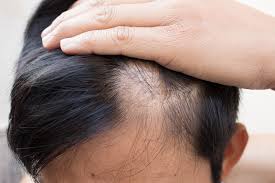Hair loss is a natural part of ageing, but that doesn’t make it any easier to deal with. For many men, noticing thinning at the crown or a receding hairline can affect confidence and self-image. In fact, it’s estimated that up to 50% of men will experience noticeable hair loss by the age of 50.
But what’s actually behind it? In this blog, we break down the most common causes of hair loss in men, explain how it all works, and explore whether it can be prevented—or at least slowed down.
How Hair Loss Happens: Understanding the Hair Growth Cycle
Before looking at the causes, it helps to understand the hair growth cycle, which includes three main phases:
- Anagen (growth phase): hair actively grows for 2–7 years
- Catagen (transitional phase): hair growth slows, lasting a few weeks
- Telogen (resting/shedding phase): hair falls out and new growth begins
When this cycle is disrupted—whether by hormones, health, or environment—hair may enter the shedding phase too early, leading to noticeable thinning over time.
Common Causes of Hair Loss in Men
Hair loss doesn’t have a one-size-fits-all cause. Here are the most common reasons men lose their hair:
Androgenetic Alopecia (Male Pattern Baldness)
This is by far the most common cause of hair loss in men. It’s a hereditary condition triggered by a sensitivity to DHT (dihydrotestosterone)—a byproduct of testosterone. DHT shrinks hair follicles over time, causing hair to grow thinner, weaker, and eventually stop growing altogether.
Male pattern baldness typically starts with a receding hairline or thinning at the crown, and progresses over time. While it can’t be “cured,” it can often be managed with treatments designed to block DHT or improve follicle function.
Hormonal Changes
Hormones don’t just play a role during puberty—they continue to influence your body well into adulthood. Imbalances, especially involving testosterone and thyroid hormones, can affect the hair cycle. Too much DHT or a thyroid disorder can accelerate hair thinning and loss.
Stress and Lifestyle Factors
High stress levels can push hair into the telogen (shedding) phase prematurely, leading to a condition known as telogen effluvium. This can be triggered by:
- Emotional stress
- Surgery or illness
- Sudden weight loss
- Lack of sleep or burnout
While this type of hair loss is often temporary, ongoing stress can prolong it.
Nutritional Deficiencies
A lack of key nutrients can weaken hair structure and slow regrowth. Common deficiencies linked to hair loss include:
- Iron
- Zinc
- Vitamin D
- B vitamins, especially biotin
If your diet lacks variety or you follow a restrictive eating plan, your hair might suffer as a result.
Scalp Conditions
A healthy scalp is essential for healthy hair. Conditions like dandruff, seborrheic dermatitis, psoriasis, or fungal infections can cause irritation, flaking, or inflammation—making it harder for follicles to function properly.
Using the right hair loss shampoo for men can help cleanse the scalp, reduce irritation, and support a healthier environment for hair growth.
Medications and Treatments
Certain medications list hair loss as a side effect. These may include:
- Antidepressants
- Acne medications (like isotretinoin)
- Blood pressure treatments
- Chemotherapy or radiation
If you’re concerned that a medication is affecting your hair, speak with your GP before making changes.
Poor Hair Care Habits
Daily grooming choices matter. Overusing heat tools, harsh styling products, or frequently wearing tight hats or hairstyles (like buns or braids) can stress the scalp and follicles. Regular use of chemical treatments or bleaching can also lead to breakage and shedding.
Early Signs of Hair Loss in Men
Spotting the signs early gives you the best chance to slow things down. Common early signs include:
- Thinning around the crown
- A receding or M-shaped hairline
- Noticeable shedding when brushing or washing
- A change in hair texture or volume
- Seeing more scalp in photos or under direct light
Can Hair Loss Be Prevented or Reversed?
While not all hair loss can be prevented, especially if it’s genetic, early action can help slow or even partially reverse it.
Prevention and Treatment Tips
- Maintain a balanced diet rich in protein, vitamins, and minerals
- Reduce stress through exercise, sleep, and mindfulness
- Avoid excessive heat styling and harsh chemical treatments
- Consider topical or oral treatments (e.g. minoxidil, finasteride)
- Use a scalp-friendly shampoo to reduce inflammation and improve follicle health
- Speak to a dermatologist or trichologist for tailored advice
FAQs: Hair Loss in Men
Is male hair loss permanent?
In cases like androgenetic alopecia, hair loss is progressive but can be slowed with treatment. Other causes, like stress or diet, may be reversible.
At what age does hair loss start?
Some men notice signs in their early 20s, but it becomes more common with age—especially after 40.
Can shampoo or supplements help?
They can support scalp health and slow shedding, but results depend on the cause and consistency of use.
Is shaving your head a solution?
It won’t stop hair loss, but many men find it a low-maintenance, confidence-boosting option.
In Summary
Hair loss in men is a complex issue, often driven by genetics, hormones, or lifestyle factors. The good news? Understanding what’s behind it can help you take the right steps to slow the process—or even restore some of what’s been lost.
Whether you’re just noticing the first signs or already well into the process, support is available. With a combination of the right hair care, a healthy lifestyle, and potentially medical advice, you can take back some control over your hair and your confidence.









